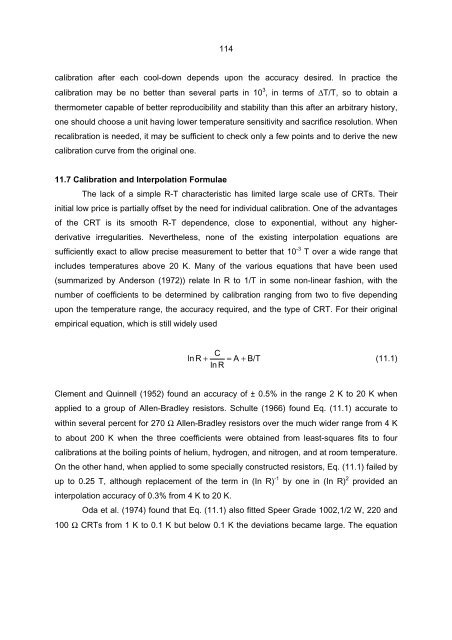techniques for approximating the international temperature ... - BIPM
techniques for approximating the international temperature ... - BIPM
techniques for approximating the international temperature ... - BIPM
Create successful ePaper yourself
Turn your PDF publications into a flip-book with our unique Google optimized e-Paper software.
114<br />
calibration after each cool-down depends upon <strong>the</strong> accuracy desired. In practice <strong>the</strong><br />
calibration may be no better than several parts in 10 3 , in terms of ∆T/T, so to obtain a<br />
<strong>the</strong>rmometer capable of better reproducibility and stability than this after an arbitrary history,<br />
one should choose a unit having lower <strong>temperature</strong> sensitivity and sacrifice resolution. When<br />
recalibration is needed, it may be sufficient to check only a few points and to derive <strong>the</strong> new<br />
calibration curve from <strong>the</strong> original one.<br />
11.7 Calibration and Interpolation Formulae<br />
The lack of a simple R-T characteristic has limited large scale use of CRTs. Their<br />
initial low price is partially offset by <strong>the</strong> need <strong>for</strong> individual calibration. One of <strong>the</strong> advantages<br />
of <strong>the</strong> CRT is its smooth R-T dependence, close to exponential, without any higher-<br />
derivative irregularities. Never<strong>the</strong>less, none of <strong>the</strong> existing interpolation equations are<br />
sufficiently exact to allow precise measurement to better that 10 -3 T over a wide range that<br />
includes <strong>temperature</strong>s above 20 K. Many of <strong>the</strong> various equations that have been used<br />
(summarized by Anderson (1972)) relate In R to 1/T in some non-linear fashion, with <strong>the</strong><br />
number of coefficients to be determined by calibration ranging from two to five depending<br />
upon <strong>the</strong> <strong>temperature</strong> range, <strong>the</strong> accuracy required, and <strong>the</strong> type of CRT. For <strong>the</strong>ir original<br />
empirical equation, which is still widely used<br />
C<br />
ln R + = A + B/T<br />
(11.1)<br />
ln R<br />
Clement and Quinnell (1952) found an accuracy of ± 0.5% in <strong>the</strong> range 2 K to 20 K when<br />
applied to a group of Allen-Bradley resistors. Schulte (1966) found Eq. (11.1) accurate to<br />
within several percent <strong>for</strong> 270 Ω Allen-Bradley resistors over <strong>the</strong> much wider range from 4 K<br />
to about 200 K when <strong>the</strong> three coefficients were obtained from least-squares fits to four<br />
calibrations at <strong>the</strong> boiling points of helium, hydrogen, and nitrogen, and at room <strong>temperature</strong>.<br />
On <strong>the</strong> o<strong>the</strong>r hand, when applied to some specially constructed resistors, Eq. (11.1) failed by<br />
up to 0.25 T, although replacement of <strong>the</strong> term in (In R) -1 by one in (In R) 2 provided an<br />
interpolation accuracy of 0.3% from 4 K to 20 K.<br />
Oda et al. (1974) found that Eq. (11.1) also fitted Speer Grade 1002,1/2 W, 220 and<br />
100 Ω CRTs from 1 K to 0.1 K but below 0.1 K <strong>the</strong> deviations became large. The equation
















